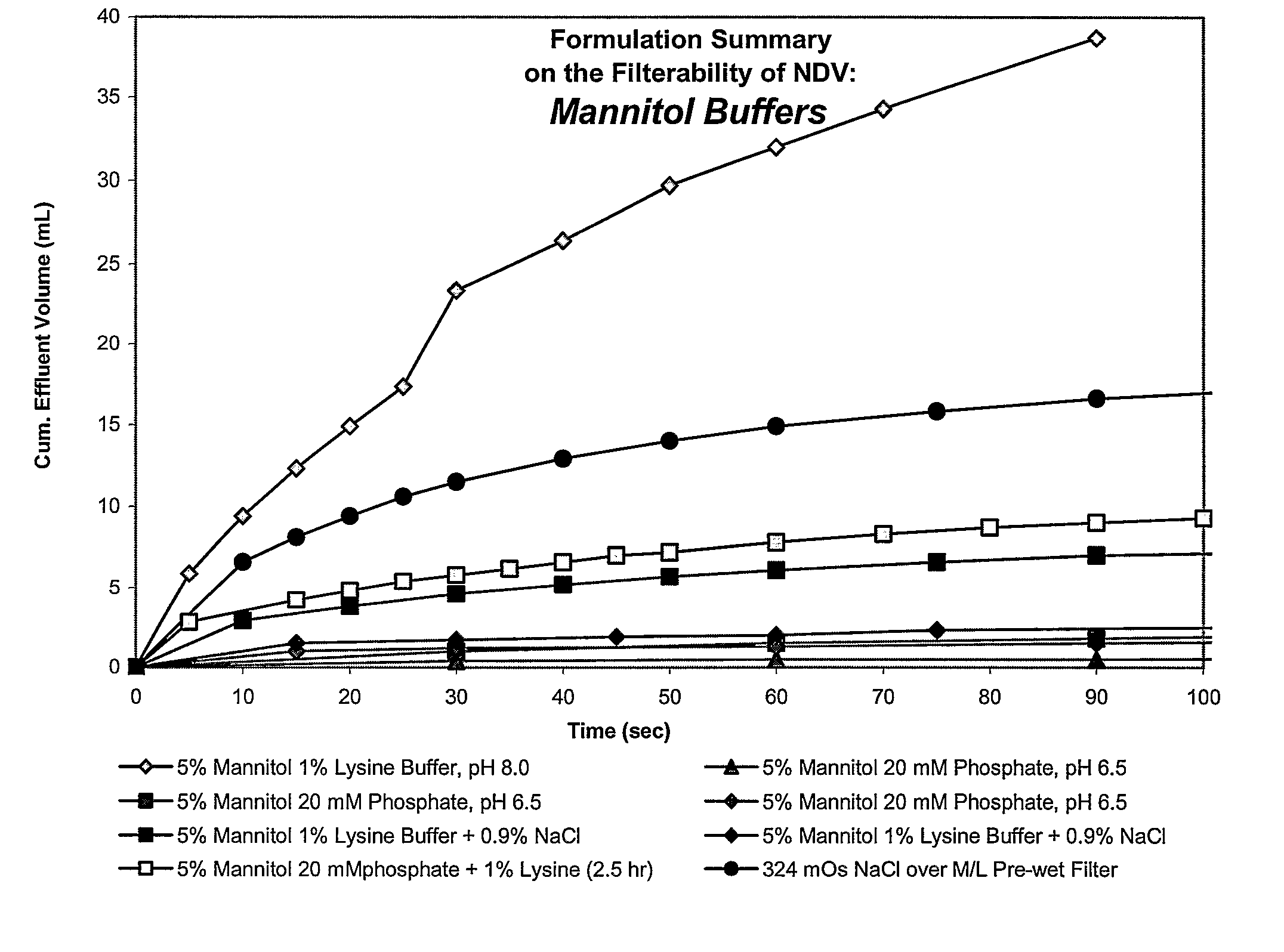Stable and Filterable Enveloped Virus Formulations
a technology of enveloped viruses and formulations, which is applied in the field of formulation of live therapeutic viruses and live virus vaccines, can solve the problems of parenteral administration adding an additional formulation and limited examples for the stabilization of frozen liquid viable virus vaccines
- Summary
- Abstract
- Description
- Claims
- Application Information
AI Technical Summary
Benefits of technology
Problems solved by technology
Method used
Image
Examples
example 1
Stability of NDV in 5% (w / v) Mannitol / 1% (w / v) Lysine Solution
[0035]NDV was derived from the mesogenic Newcastle disease virus strain Mass-MK107 by triple plaque purification and produced by inoculation of the virus in the allantoic fluid cavity of 10 days old embronated chicken eggs. After incubation at 36° C. for 2 days, the eggs were chilled and the allantoic fluid harvested. The harvested allantoic fluid was diafiltered with 5% (w / v) D-mannitol and 1% (w / v) L-lysine, pH 8.0 buffer (ML), clarified and purified by tangential flow filtration and size exclusion chromatography to a concentration of 1 to 4 E+10 PFU / mL, aliquoted and stored at −20° C. NDV titer was measured by plaque assay and expressed as the amount of infectious NDV plaque forming units (PFU) per milliliter. For this assay, human HT1080 fibrosarcoma cells were seeded into tissue culture plates and grown to confluence. The growth medium was removed, the cell monolayers washed with medium and 0.5 mL of NDV sample added...
example 2
Stability of NDV in 10% (w / v) Sucrose Solution
[0036]NDV was prepared by method described in example 1, buffer exchanged into a 10% (w / v) sucrose solution by tangential flow filtration and size exclusion chromatography, aliquoted and stored at −20° C. Stability was measured by plaque assay as described in example 1. The results (Table II) indicated that NDV stored at −20° C. in 10% (w / v) sucrose was stable for up to 24 months.
TABLE IIStability of NDV 10% (w / v) Sucrose formulation at −20° C.% Activity RemainingLot #3 Month6 Month12 Month18 Month24 Month11001008291100283NT96NTNT3799372NTNT*NT: Not Tested
example 3
Stability of NDV in 10% (w / v) Sucrose Solution Containing Other Excipients
[0037]NDV was prepared by the method described in example 1 and buffer exchanged into a 10% (w / v) sucrose solution by tangential flow filtration and size exclusion chromatography. Separate formulations of NDV in 10% (w / v) sucrose containing an amino acid were prepared by the addition of either L-lysine, L-glycine or L-glutamic acid to a final concentration of 1% (w / v). The formulations were aliquoted and stored at −20° C. Stability was measured by plaque assay as described in example 1. The results (TABLE III) indicated that NDV stored at −20° C. in 10% (w / v) sucrose containing 1% lysine, 1% glycine or 1% glutamic acid was stable for up to 14 months.
TABLE IIIStability of NDV in 10% (w / v) sucrose containingamino acids at −20° C.% Activity RemainingNDV / buffer4 Months14 Months10% Sucrose / 1% (w / v) L-Lysine100%138%(pH 6.5)10% Sucrose / 1% (w / v) L-Glycine105%115%(pH 6.5)10% Sucrose / 1% (w / v) L-Glutamic Acid100%107%(pH ...
PUM
| Property | Measurement | Unit |
|---|---|---|
| Temperature | aaaaa | aaaaa |
| Molar density | aaaaa | aaaaa |
| Electric charge | aaaaa | aaaaa |
Abstract
Description
Claims
Application Information
 Login to View More
Login to View More - R&D
- Intellectual Property
- Life Sciences
- Materials
- Tech Scout
- Unparalleled Data Quality
- Higher Quality Content
- 60% Fewer Hallucinations
Browse by: Latest US Patents, China's latest patents, Technical Efficacy Thesaurus, Application Domain, Technology Topic, Popular Technical Reports.
© 2025 PatSnap. All rights reserved.Legal|Privacy policy|Modern Slavery Act Transparency Statement|Sitemap|About US| Contact US: help@patsnap.com


